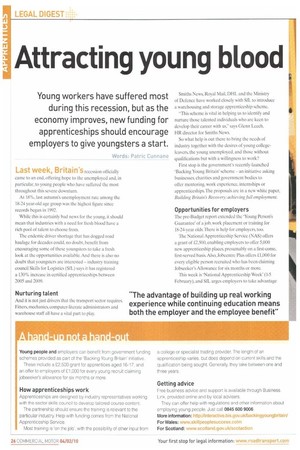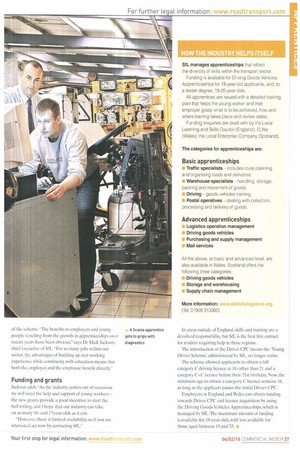Attracting young blood
Page 26

Page 27

If you've noticed an error in this article please click here to report it so we can fix it.
Young workers have suffered most during this recession, but as the economy improves, new funding for apprenticeships should encourage employers to give youngsters a start.
Words: Patric Cunnane
Last week Britain's Last week Britain's
recession officially came to an end, offering hope to the unemployed and, in particular, to young people who have suffered the most throughout this severe downturn.
At 18%, last autumn's unemployment rate among the 18-24 year-old age group was the highest figure since records began in 1992.
While this is certainly bad news for the young, it should mean that industries with a need for fresh blood have a rich pool of talent to choose from.
The endemic driver shortage that has dogged road haulage for decades could, no doubt, benefit from encouraging some of these youngsters to take a fresh look at the opportunities available. And there is also no doubt that youngsters are interested — industry training council Skills for Logistics (SfL) says it has registered a 130% increase in certified apprenticeships between 2005 and 2009.
Nurturing talent
And it is not just drivers that the transport sector requires Fitters, mechanics, computer-literate administrators and warehouse staff all have a vital part to play. Smiths News, Royal Mail, DHL and the Ministry of Defence have worked closely with SfL to introduce a warehousing and storage apprenticeship scheme.
"This scheme is vital in helping us to identify and nurture those talented individuals who are keen to develop their career with us," says Glenn Leech, HR director for Smiths News.
So what help is out there to bring the needs of industry together with the desires of young collegeleavers, the young unemployed, and those without qualifications but with a willingness to work?
First stop is the government's recently-launched 'Backing Young Britain' scheme — an initiative asking businesses, charities and government bodies to offer mentoring. work experience, internships or apprenticeships. The proposals are in a new white paper, Building Britain's Recovery: achieving full employment.
Opportunities for employers
The pre-Budget report extended the 'Young Person's Guarantee' of a job, work placement or training for 18-24-year olds. There is help for employers, too.
The National Apprenticeship Service (NAS) offers a grant of £2,500, enabling employers to offer 5,000 new apprenticeship places, presumably on a first-come, first-served basis. Also, Jobcentre Plus offers £1,000 for every eligible person recruited who has been claiming Jobseeker's Allowance for six months or more.
This week is 'National Apprenticeship Week' (1-5 February). and SfL urges employers to take advantage of the scheme. "The benefits to employers and young people resulting from the growth in apprenticeships over gets to grips with
recent years have been obvious," says Dr Mick Jackson, diagnostics
chief executive of Sfl... "For so many jobs within our
sector, the advantages of building up real working experience while continuing with education means that both the employer and the employee benefit directly.
Funding and grants
Jackson adds: As the industry comes out of recession, we will need the help and support of young workers — the new grants provide a good incentive to start the ball rolling, and I hope that our industry can take on as many 16and 17-year-olds as it can.
"However, there is limited availability. so if you are interested act now by contacting SfL."
In areas outside of England, skills and training are a devolved responsibility, but SfL is the best first contact for readers requiring help in those regions.
The introduction of the Driver CPC means the 'Young Driver Scheme'. administered by SfL. no longer exists.
The scheme allowed applicants to obtain a full category C driving licence at 18 rather than 21 and a category C-i-E licence before their 21st birthday. Now, the minimum age. to obtain a category C licence remains 18, as long as the applicant passes the initial Driver CPC.
Employers in England and Wales can obtain funding towards Driver CPC and licence acquisition by using the Driving Goods Vehicles Apprenticeships, which is managed by SfL. The maximum amount of funding is available for 18-year-olds, with less available for those aged between 19 and 25. a




































































































































